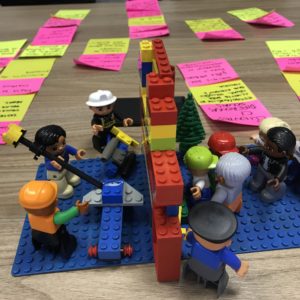After two years conducting field studies about the participation of healthcare professionals in construction projects, I decided to make a board game based on my findings.
The target players are those same professionals I’m studying. The idea is that the construction and healthcare professionals can switch their roles for a while and understand their different conditions and perspectives. This could be done before participatory workshops, as a warm up.
The major advantage of playing the the board game is that it simulates in 2 hours a process that usually takes more than 5 years. Of course the simulated process is not very realistic, but the point is to raise mutual awareness between the players.
Here is how the game looks like:
The board is a construction site where you can build blocks with the required engineered services (electricity, water, gas, etc) by the medical facilities. After they are functional, facilities are used to treat patients, who are waiting at the queue (pink cards). Sometimes, the patient cannot be admited to the hospital because the insurance company does not cover that particular illness. The insurance policy are changing all the time (blue cards), so the hospital must grow flexible.
Each player has a different role in the game: architect, engineer, and builder in the construction team; nurse, hospital director, and facility manager in the healthcare team. Every action costs money, so players must be wise in making decisions that are good for themselves at the same time that it is good for the hospital.
This is the primary contradiction that I found in the projects that I studied here in The Netherlands. Building a hospital is a collective achievement of many different parties. It is very complex and no one has control over the entire process. Parties are constantly facing the contradiction between their own interests and the emergent societal needs. Because there is no centralized responsibility, every partner must face that contradiction on his own.
This is manifested in the game by two accounts: the hospital account and the player’s account. Players can decide how much money they will earn from the hospital. If they ask for too much, the hospital is bankrupt. Negotiation is supposed to happen within pairs: the architect versus hospital director about the budget; the architect and the engineer about the services; the facility manager versus the nurse about the position of the facilities, and so on.
What happened during the first round of playtesting of the game is that the negotiation became chaotic and players stepped back. Because it was too hard to find win-win situations they just decide to play by their own interests and ended up making the hospital goes bankrupt in a few rounds.
I’m now working in the game balance to ease the negotiation process and create more benefits for collaboration, but I still want to let the player choose either to collaborate or to be egoisthic. I think that having the opportunity to experience contradictions is the best way to understand them.
In that sense, the game offers me an opportunity to communicate the core of my research in a way that no other medium can do.



